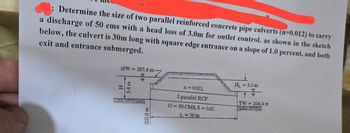
Fundamentals of Geotechnical Engineering (MindTap Course List)
5th Edition
ISBN: 9781305635180
Author: Braja M. Das, Nagaratnam Sivakugan
Publisher: Cengage Learning
expand_more
expand_more
format_list_bulleted
Question
Please solve

Transcribed Image Text:2: Determine the size of two parallel reinforced concrete pipe culverts (n=0.012) to carry
a discharge of 50 cms with a head loss of 3.0m for outlet control. as shown in the sketch
below, the culvert is 30m long with square edge entrance on a slope of 1.0 percent, and both
exit and entrance submerged.
HW207.4 m-
H
E
202.0 m
H₁ = 3.0 m
n = 0.012
2 parallel RCP
TW 204.4 m
O=50 CMS, S = 0.01
L-30 m
Expert Solution
This question has been solved!
Explore an expertly crafted, step-by-step solution for a thorough understanding of key concepts.
Step by stepSolved in 2 steps with 2 images

Knowledge Booster
Similar questions
- Redo Problem 14.1 with the following: L1 = 3m, L2 = 6 m, γ = 17.3 kN/m3, γsat = 19.4 kN/m3, and ϕ′ = 30°. 14.1 Figure P14.1 shows a cantilever sheet-pile wall penetrating a granular soil. Here, L1 = 4 m, L2 = 8 m, γ = 16.1 kN/m3, γsat = 18.2 kN/m3, and ϕ′ = 32°. What is the theoretical depth of embedment, D? For a 30% increase in D, what should be the total length of the sheet piles? Determine the theoretical maximum moment of the sheet pile.arrow_forwardRefer to Figure 18.9. A cantilever sheet pile is driven into a granular soil where the water table is 2 m (L1) below the top of the sand. The properties of the sand are =40, =17.5kN/m3, and sat=19kN/m3. It is proposed to excavate to a depth of 6 m (L) below the ground level. Determine the actual depth to which the sheet pile must be driven (L + D), using the net lateral pressure diagram. Note: Dactual=1.3(L3+L4)theoryarrow_forwardRefer to Figure 7.24. The following data were collected during the field permeability measurement of a confined aquifer using a pumping test. Determine the hydraulic conductivity of the permeable layer. Use Eq. (7.49). Thickness of the aquifer, H = 4.5 m Piezometric level and radial distance of the first observation well: h1 = 2.9 m; r1 = 17.8 m Piezometric level and radial distance of the second observation well: h2 = 1.8 m; r2 = 8.1 m Rate of discharge from pumping, q = 0.5 m3/minarrow_forward
arrow_back_ios
arrow_forward_ios
Recommended textbooks for you
 Fundamentals of Geotechnical Engineering (MindTap...Civil EngineeringISBN:9781305635180Author:Braja M. Das, Nagaratnam SivakuganPublisher:Cengage Learning
Fundamentals of Geotechnical Engineering (MindTap...Civil EngineeringISBN:9781305635180Author:Braja M. Das, Nagaratnam SivakuganPublisher:Cengage Learning Traffic and Highway EngineeringCivil EngineeringISBN:9781305156241Author:Garber, Nicholas J.Publisher:Cengage Learning
Traffic and Highway EngineeringCivil EngineeringISBN:9781305156241Author:Garber, Nicholas J.Publisher:Cengage Learning Principles of Foundation Engineering (MindTap Cou...Civil EngineeringISBN:9781337705028Author:Braja M. Das, Nagaratnam SivakuganPublisher:Cengage Learning
Principles of Foundation Engineering (MindTap Cou...Civil EngineeringISBN:9781337705028Author:Braja M. Das, Nagaratnam SivakuganPublisher:Cengage Learning Principles of Geotechnical Engineering (MindTap C...Civil EngineeringISBN:9781305970939Author:Braja M. Das, Khaled SobhanPublisher:Cengage Learning
Principles of Geotechnical Engineering (MindTap C...Civil EngineeringISBN:9781305970939Author:Braja M. Das, Khaled SobhanPublisher:Cengage Learning Principles of Foundation Engineering (MindTap Cou...Civil EngineeringISBN:9781305081550Author:Braja M. DasPublisher:Cengage Learning
Principles of Foundation Engineering (MindTap Cou...Civil EngineeringISBN:9781305081550Author:Braja M. DasPublisher:Cengage Learning

Fundamentals of Geotechnical Engineering (MindTap...
Civil Engineering
ISBN:9781305635180
Author:Braja M. Das, Nagaratnam Sivakugan
Publisher:Cengage Learning

Traffic and Highway Engineering
Civil Engineering
ISBN:9781305156241
Author:Garber, Nicholas J.
Publisher:Cengage Learning

Principles of Foundation Engineering (MindTap Cou...
Civil Engineering
ISBN:9781337705028
Author:Braja M. Das, Nagaratnam Sivakugan
Publisher:Cengage Learning

Principles of Geotechnical Engineering (MindTap C...
Civil Engineering
ISBN:9781305970939
Author:Braja M. Das, Khaled Sobhan
Publisher:Cengage Learning

Principles of Foundation Engineering (MindTap Cou...
Civil Engineering
ISBN:9781305081550
Author:Braja M. Das
Publisher:Cengage Learning
